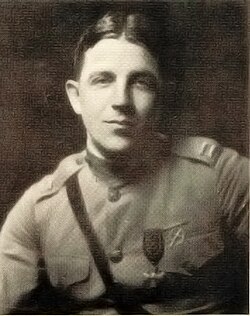Laurence Stallings
| Laurence Stallings | |
|---|---|

Stallings c. 1918. Photo by Arnold Genthe. Note the Croix de Guerre.
|
|
| Born | Laurence Tucker Stallings November 25, 1894 Macon, Georgia |
| Died | February 28, 1968 (aged 73) Pacific Palisades, California |
| Occupation | Playwright, Novelist, Screenwriter |
| Notable works |
Plumes What Price Glory |
| Notable awards | Croix de Guerre Silver Star Photoplay Gold Medal • The Big Parade (1925) |
| Spouse |
|
Laurence Tucker Stallings (November 25, 1894 - February 28, 1968) was an American playwright, screenwriter, lyricist, literary critic, journalist, novelist, and photographer. Best known for his collaboration with Maxwell Anderson on the 1924 play What Price Glory, Stallings also produced a groundbreaking autobiographical novel, Plumes, about his service in World War I, and published an award-winning book of photographs, The First World War: A Photographic History.
Stallings was born Laurence Tucker Stallings in Macon, Georgia, to Larkin Tucker Stallings, a bank clerk, and Aurora Brooks Stallings, a homemaker and avid reader who inspired her son's love of literature. He entered Wake Forest University in North Carolina in 1912 and became the editor of the campus literary magazine, the Old Gold and Black.
He met Helen Poteat while at Wake Forest. She was the daughter of Dr. William Louis Poteat, the university president, and the sister of Stallings's classics professor. They were sweethearts throughout their school years. He graduated from Wake Forest College in 1916, and got a job writing advertising copy for a local recruiting office. He was so convinced by his own prose, he joined the United States Marine Reserve in 1917. He left Philadelphia for overseas duty in France aboard the USS Henderson on 24 April 1918. In France, he served as a platoon commander with 3rd Battalion, 5th Marines during the fighting at Château-Thierry. He was wounded in the leg in the Battle of Belleau Wood after charging an enemy machine-gun nest on 25 June. After begging the doctors not to amputate, he went home to spend two painful years recuperating at the Brooklyn Naval Hospital. He later damaged it with a fall on the ice, and it was amputated in 1922. Many years later, he had to have his remaining leg amputated, as well. After finishing his convalescence, Stallings and Poteat married on March 8, 1919; they had two daughters, Sylvia (born 1926) and Diana (born 1931), before divorcing in 1936. In 1928-1929, they restored Poteat House near Yanceyville, North Carolina. Through Helen his aunt by marriage was the painter Ida Isabella Poteat.
...
Wikipedia
